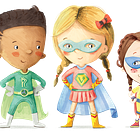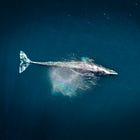Interview: Paul J. Burgess
On pigeons, helping kids find compassion for animals, and drawing inspiration from the world around us
Welcome back to another Wizard of Claws interview!
You may recognize Paul as one-half of the dynamic duo that is Those Vegan Guys on social media, but today Paul will be discussing his new book, Penny the Pigeon Queen. A lovely little children’s book about a rather regal pigeon and the kids who stick up for her, this story shows us that kindness is the most powerful magic.
General Questions
Can you share a little bit about yourself, including how you came to care about animals and creative writing?
I’ve been writing for much of my life, starting with essays in junior school for which I received high praise from my teachers. Writing has always been a core part of who I am and over the years I have written poems, (published) plays, short plays, short stories and so much more. It is a real outlet for me.
Caring for animals has also always been prevelent but there was one particular incident, over 30 years ago, that sticks with me. My mother asked me to go to the shops for her and buy a leg of lamb for Sunday lunch. On the way there it suddenly hit me that I was going to buy a lamb’s leg, not a conveniently worded Sunday lunch item but a limb from an animal that had been killed for that purpose, to be cut up into pieces for human consumption. It wasn’t too long after this incident that I went to a local art gallery and saw a very thought provoking piece of digital art that would change me, for good. There were three TV screens and in front of each was a circle painted on the floor saying ‘stand here.’ I stood in the first circle and was greeted with images of nature on the TV screen, birds in trees, fish in water, beautiful countryside etc. The images ended and the screen went blank as the next screen lit up, and so I moved into the circle in front. The images in this reel were industrial, factories, steel works, big ships. Lots of noise. Again this ended and I moved to the final screen. It was animal slaughter! I almost walked away, but I didn’t. I stayed and watched it all, and it broke a part of me. I became vegetarian that day. Years later, I watched a documentary on Netflix called Vegucated on the recommendation of a friend. I watched it twice, and on the second viewing I became vegan, immediately. I’ve never looked back.
Many of us have childhood dreams of becoming a writer. When did you decide to go for it?
I think in College, I was doing a performing arts course and this gave me the freedom to flex my writing skills. I wrote a short play first called ‘Seven scenes.’ It was exactly that, seven scenes, four characters, a sort of life timeline from small children to pensioners. I then went on to write ‘Every Single One of Me,’ a full length play with an interval, all about a guy with multiple personality disorder who sees his other personalities become flesh and bone people in his home, and the play documents their journey to reintegrate. I loved writing it so much, and it was even better acting in it and directing it. I’ve also written poems which have been published in anthologies. ‘Penny The Pigeon Queen,’ now published, is my first solo publication, my first published book, and I couldn’t be happier that it is out there in the world now.
Most animal advocacy focuses on creating tangible changes in the real world. What role can the arts play in changing how people think about animals?
I refer back to my first answer about my own veggie and vegan journey, it was in fact that art installation that changed me. It was then a documentary that pushed me further. Art has incredible power to move us in ways other things cannot. People can get inspired by the simple wording of a quote, a scene in a movie or on the stage, the lyrics of a song, and all of these things fall under the big and beautiful umbrella that is art. A person can tell you that you should change something about yourself, and it can seem like a demand, or a criticism, but if we show you a journey, with a character, be it in written or acted form, even sung, if you can see and hear how this journey changed this character, then maybe, just maybe, you will be inspired to change yourself.
What is it about animals that inspires you to write about them?
The fact that they can’t. If they could, they would tell us tales of how our world affects them, how the things we do and the way we treat them impacts their lives, and promotes that treatment or indifference to others. If we, as purveyors of art CAN see, then we should say. It is and always has been the duty of good human beings to stand up and shout out for those who can’t.
What connections, if any, do you see between the vegan and LGBTQ+ communities?
Oppression. We, as both Those Vegan Guys (with my husband Jason) and The Vegan Queens (with my best friend Stuart), have often made that correlation in vlogs and/or on stage. We as a community have been and in many ways still are oppressed, and too many countries still label us as dangerous, deviant, illegal! The links are right there. Oppression connects us, and is always worth fighting against. It is our duty to do so.
What does “down-to-earth veganism” mean to you?
This was our own coined phrase to describe who we are and the kind of veganism we promote. It is about being realistic, and making a switch to veganism as easy as possible. Not worrying about having processed foods, not thinking that you have to make everything from scratch with hard to find ingredients, but simply switching to vegan products as much like the non-vegan products you are used to. Keeping it down-to-earth has helped literally thousands of people to make the switch, using our shopping vlogs and meals vlogs as guides.
Story Questions
You wrote in your acknowledgments that the pigeons of Oldham inspired Penny the Pigeon Queen. How did the idea for this story first come to you? Did your original idea change at all as you developed it?
It was actually a rather nasty interaction that led to the book. I was in my hometown town centre feeding the pigeons one day when a small child came running into the feeding circle screaming loudly and laughing, of course all the pigeons flew away and so I said to the child,
“Please don’t do that little one, can you imagine if a giant pigeon came running at you? Why not feed them with me?”
The child reached out their hand for some seeds, and then the mother came along, shouting.
“Don’t you tell my fuc*ing child what to do!”
I asked her to please not use profanity in front of her child, who had heard and understood me, who was reaching for seeds to share. She continued swearing and screaming at me as she walked away.
The seed was planted at that moment. How could I as a writer share the message that ALL animals are important and deserve respect.
Penny the Pigeon Queen came flooding into my mind, and I knew I had to write a children’s book. If parents can’t spread compassion, maybe art can.
Anthropomorphism is always an area of contention among vegans when it comes to using animals in fiction. In what ways did anthropomorphism (or Penny’s ability to understand and communicate with humans) aid this story, and in what ways did you want to stay true to pigeons’ natural behavior?
Now, the thing with anthropomorphism is that it is a core part of who I am as a person, only I do it with most things. Buildings, food items, clothing. It was something I only really acknowledged about myself over recent years but have done all of my life. Important to note before answering this one.
In the book, it is only Penny who can ‘talk.’ Only she can perform magic, change size, colour, shape. I needed her to be able to fully communicate with the children, for them to fully understand her and her message. For her to be all that I felt she needed to be, she had to be magic, and she had to be the Queen. Her pigeon people are all the ones we see in our towns and parks, every day. No less important or special, just a little less communicative. ;)
Are any of the characters inspired by people (human or nonhuman) you’ve known?
Of course, they had to be. Every character in the book is an amalgamation of many people I have known, or still know in life. They are all collections of characteristics and quirks, of personalities and idiosyncrasies that make up the human species, simplified for a younger reader, but still visible for the parents or guardians.
How did you come to work with your illustrator, Helen Woods Horley?
Helen, a fabulous artist for the record, actually started out as one of our viewers and subscribers on YouTube. As with many people over the years, we connected there and then through our group on Facebook, where she shared many of her sketches and drawings. We became friends, and when I needed an illustrator for the book, Helen was right there to ask.
Can you share a bit about how you got this book published with Nightingale Books? Did you consider going the more traditional route of finding a literary agent first?
As soon as I had finished the book and felt it was ready for consumption I wanted it out there. It wasn’t written to make money, it was written to tell a story and inspire compassion, so the sooner the better. I sent it out to a few publishers and told myself that the first one to come back (if any did) with a reasonable offer or agreement I would sign. Pegasus Publishers/Nightingale Books was the first to offer me a contract I was okay with, and here we are. I’ll be honest and tell you that I agreed to and signed a hybrid deal, which meant I had to pay part of the publication costs, but if it meant getting the story out there, not only in my own country but across the world, then it was worth it. I’ve never been one to do things ‘by the book’, and this scenario was no different.
How was writing kidlit different from your past experiences writing plays, poetry, and short stories? How was it similar?
It was in fact very different from my usual writing. I had to be a boy again to write Penny. I had to first think about all the things that grabbed my mind as a child, then try to figure out why they had. Those were the things that I wanted to make sure were in the book, however small or insignificant they may seem. The core of it was always magic, so a belief in magic and that anything is possible fuelled the story. I’ve never written in that way or from that place before but I highly recommend it, and I can’t wait to do it again.
What message do you hope readers will take away from this book?
That when we allow our children to run into a flock of pigeons to scare them away and we don’t say anything, we tell them that doing that is okay. Pigeons are often the first and most common wild (now) beings that we experience in abundance as children. It is the ideal opportunity to learn about compassion for other beings, to learn about the history of pigeons (coming in book two) and how important they once were to us humans. Most parents just laugh and let the actions continue. I deeply hope to help change that.
Final Questions
How can readers find you and your stories online?
Those Vegan Guys: website, YouTube, Facebook, Instagram, BlueSky
Any upcoming projects?
Penny has another story to tell, currently has all the ingredients for that one but haven’t started cooking as yet.
The Vegan Queens will be hosting Mind & Body after dark at Vegan Camp Out again this year, (it was actually our idea) after a hugely successful run last year. 4.5 hours per night on Saturday and Sunday of cabaret, burlesque, drag, music and karaoke. It was a hit and we can’t wait to do it again. As for Those Vegan Guys, we will continue our regular YouTube output and continue to hope that we help as many people as possible to choose veganism.
Anything else you’d like to share?
If you have a story to share that you think will help others, write it! To use a few of my husband's lyrics which I love. “Be all that you can be, and live your life with joy.” x








